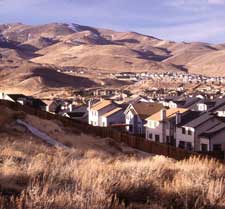One does not expect enlightenment from a barber shop conversation, but there it was. I’d always had hunches about the nature of demographic change in Western mountain towns, nasty hunches, hunches counter to the conventional wisdom that immigration was motivated by the newcomers’ love of the land, so the newcomers would become allies in environmental struggles. Nothing, however, explained my skepticism, other than the simple fact that the political struggles of my place steadily grew harder and meaner, despite the newcomers.
The woman in the barber shop was prattling on about the charms of Missoula, Montana, my hometown, her new hometown.
“It’s just like a little San Francisco.”
I baited: “So is that where you’re from?”
“No, L.A., but it’s like a little San Francisco here.”
“Well, actually, no. It’s all white. No ethnic diversity, and San Francisco is nothing if not diverse. This place is all white.”
“I know. Isn’t it wonderful.”

Photo: Photos To Go, © 1999.
Did I mention the newcomer was white? Of course not. Didn’t need to. They almost all are.
I offer here another name for the migration of coastal urbanites into the mountain towns of the Rockies and Cascadia: white flight. Writing in March in the New York Times, California journalist Dale Maharidge offered this observation: “California is now essentially one large urban core, with the intermountain West as its suburb.”
He says that’s how it feels from his end in Palo Alto, and that’s how it feels from mine in Missoula. A majority of Californians now are not white. As immigrants grow wealthy enough to afford suburban homes, the white flight that built the suburbs in the first place flees on.
So now we have a name for it, what does it mean? Folks who analyze the primary changes of America during the last decade mark them by the impoverishment of both cities and rural areas, then talk about a rural-urban split. The poverty is right, but the split is wrong; this analysis misses the point, and it misses more than half of the U.S. population, which is neither rural nor urban but suburban. This majority is a new one; its emergence the dominant factor of American politics in this generation. Suburbanites gave us Ronald Reagan and his spawn. The same force erased John Kennedy’s question about what we can do for country and replaced it with the legitimized greed present in Reagan’s pivotal question: “Are you better off today than you were four years ago?”
What Maharidge believes this portends for mountain towns like mine is increasingly conservative politics. My state, for instance, once the most Democratic of the intermountain West, can no longer seem to elect a Democrat. True enough, there has always been a large conservative element in the state, like Washington’s and Oregon’s, based in its eastern agricultural half, ranchers and farmers, not newcomers. But as of the last elections, there was not a single Democrat in Flathead County in any elected office, and Flathead is among the three fastest growing in the state, on the west side, a glitz county, a magnet for immigrants. Maharidge is right.
I worry about what this new conservative, suburban force portends for environmental politics, as opposed to pure partisan politics. Remember, we were counting on the newcomers for some help. So what sort of help might they give? It depends on what one means by environmental politics.
What I mean by environmentalism is the growing understanding that the earth is finite and intricate, that it supports our existence here only to the degree we respect its limits and preserve its intricacy. Pondering this fundamental can quickly bring the conclusion that life will be grim indeed for most of the world’s 6 billion souls if a few go on consuming resources at literally 20 times the rate of the rest.
Suburban America is not about respecting limits.
The rubber-stamped chain malls have begun to ring my city, monuments to the founding fact of suburban existence, which is consumption. The sport utes stream down the valley highway that flees the city to the gridlock of new trophy homes with arched windows craning to steal a vantage of the horizon’s unspoiled peaks. All of this seems to say: “I got mine.”
Where is the recognition of limits here that will bring on the real sacrifices necessary to preserve the very wilderness and wildlife those arching windows want to see?
Of course, there is another view of environmental politics, one evolved from the legitimate fear of poisons, but one that eventually distills that fear to the point it can only be understood with the subject “I.” This explains why so many of those gas-guzzling sport utes can be found parked at the local health food store. The acronym that covers this branch of environmentalism is NIMBY-ism, a belief that a problem is not a problem unless it occurs in my backyard. But it’s okay if the effects of my consumption foul someone else’s. This is the companion sentiment to “I got mine.” I expect to hear a good deal more about it.


